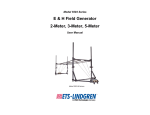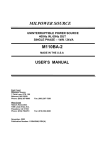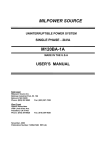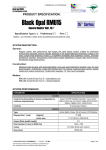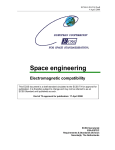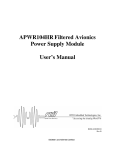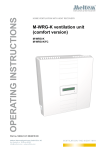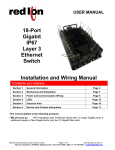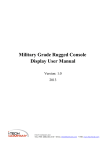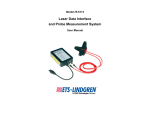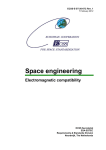Download Manual - ETS
Transcript
Model 7605 / Model 7606 Radiating Loop & Loop Sensor User Manual For MIL-STD-461D Tests In Accordance With Method RS101 of MIL-STD-462D ETS-Lindgren L.P. reserves the right to make changes to any product described herein in order to improve function, design, or for any other reason. Nothing contained herein shall constitute ETS-Lindgren L.P. assuming any liability whatsoever arising out of the application or use of any product or circuit described herein. ETS-Lindgren L.P. does not convey any license under its patent rights or the rights of others. © Copyright 1999–2010 by ETS-Lindgren L.P. All Rights Reserved. No part of this document may be copied by any means without written permission from ETS-Lindgren L.P. Trademarks used in this document: The ETS-Lindgren logo is a trademark of ETS-Lindgren L.P. Revision Record MANUAL MODEL 7605/7606 MILSTD 461D RS101 | Part # 399222, Rev. B ii Revision Description Date A Initial Release April, 1999 B Rebrand July, 2010 | Table of Contents Notes, Cautions, and Warnings ................................................ v About This Manual ................................................................... vii 1.0 Introduction .......................................................................... 9 About Model 7605 ........................................................................................ 10 About Model 7606 ........................................................................................ 10 References .................................................................................................. 11 ETS-Lindgren Product Information Bulletin ................................................. 12 2.0 Maintenance ....................................................................... 13 Annual Calibration ....................................................................................... 13 Service Procedures ..................................................................................... 13 3.0 Specifications..................................................................... 15 Electrical Specifications ............................................................................... 15 Physical Specifications ................................................................................ 15 4.0 Theory of Operation........................................................... 17 Schematic of 7605/7606 in Calibration Configuration.................................. 17 Model 7605 .................................................................................................. 18 Equation 1............................................................................................ 18 Equation 2............................................................................................ 18 Model 7606 .................................................................................................. 19 Equation 3............................................................................................ 19 Equation 4............................................................................................ 19 Equation 5............................................................................................ 20 Equation 6............................................................................................ 20 Equation 7............................................................................................ 20 Conversion Factors for Model 7606..................................................... 21 Equation 8............................................................................................ 22 5.0 MIL-STD-462D Method RS101 Testing ............................. 23 Operational Cautions ................................................................................... 23 Assembly for Calibration .............................................................................. 24 Method RS101 Calibration ........................................................................... 25 Required instrumentation..................................................................... 25 | iii About the Signal Source ...................................................................... 26 About the Measuring Instruments ........................................................ 27 About the Current Probe ...................................................................... 27 Calibration Steps ................................................................................. 28 Disassembly for Method RS101 Testing ..................................................... 29 Method RS101 Testing ................................................................................ 30 Start the EUT ....................................................................................... 31 Select Test Frequencies ...................................................................... 31 Equation 9 ................................................................................... 33 Testing the EUT ................................................................................... 34 Equation 10 ................................................................................. 34 Model 7606 Calibration Calculations ........................................................... 34 Calibration by Calculation .................................................................... 35 Equation 11 ................................................................................. 35 Equation 12 ................................................................................. 35 Equation 13 ................................................................................. 36 Equation 14 ................................................................................. 36 Traceability to NIST ............................................................................. 37 Appendix A: Warranty ............................................................. 39 iv | Notes, Cautions, and Warnings Note: Denotes helpful information intended to provide tips for better use of the product. Caution: Denotes a hazard. Failure to follow instructions could result in minor personal injury and/or property damage. Included text gives proper procedures. Warning: Denotes a hazard. Failure to follow instructions could result in SEVERE personal injury and/or property damage. Included text gives proper procedures. See the ETS-Lindgren Product Information Bulletin for safety, regulatory, and other product marking information. | v This page intentionally left blank. vi | About This Manual Numbers enclosed in square brackets correspond to the references listed in References on page 11. • This manual explains the theory of operation of the Model 7605 Radiating Loop and Model 7606 Radiating Sensor, and the use of the set for MIL-STD-462D [1] electromagnetic interference (EMI) testing. • The scope of this manual includes only the theory of operation, calibration, and use of Model 7605 and Model 7606 for EMI testing in accordance with Method RS101 [2] of MIL-STD-462D. • The use of Model 7605 and Model 7606 for other purposes in electromagnetic compatibility (EMC) testing is limited only by the ingenuity of the user, but uses in addition to MIL-STD-462, Method RS101 EMI testing are not included. • The international system of units (SI) is used throughout this manual. Refer to IEEE Std 268 [3] for correct abbreviations and their proper use, and IEEE Std 260 [4] for the proper use of units with the decibel symbol (dB). • In general, definitions of EMC terms are contained in ANSI C63.14 [5] and other electrical terms in IEEE Std 100 [6]. | vii This page intentionally left blank. viii | 1.0 Introduction The ETS-Lindgren Model 7605 Radiating Loop and Model 7606 Radiating Sensor are provided as a set, and are used together for the test equipment calibration described in Method RS101 of MIL-STD-462D. Model 7605 is used separately during susceptibility (immunity) testing of Equipment Under Test (EUT). Use the included nylon bolt to connect the Model 7605 and Model 7606 together. Do not use a metallic bolt or calibration will be inaccurate. Shown unassembled Shown assembled Introduction | 9 About Model 7605 • Model 7605 is a 20-turn coil of AWG-12 enamel-insulated copper wire. It is wound in a groove on a coil form made of a polytetrafluoroethylene (PTFE) material. The average diameter of the coil is 12 cm (120 mm). • The coil form is extended to provide a built-in 5-cm spacer to keep the coil at the required distance from the EUT. A slot with a threaded screw hole is cut into the end of the spacer to attach the Model 7606. • The coil is used to expose EUT to magnetic fields in the range of 30 Hz to 100 kHz. It produces a magnetic field that has a flux density of 7 9.5 x 10 picotesla per ampere (pT/A) of current flowing in it at an axial distance of 5 cm (50 mm) from the center. In decibels, this is 160 dB(pT/A). The coil can carry 15 A rms (root mean square) of alternating current with only ambient cooling. About Model 7606 • Model 7606 is a 4-cm (40-mm) diameter, electrostatically-shielded loop antenna with 51 turns of 7-strand AWG-41 litz wire. • The Model 7606 is used to calibrate the Model 7605 and associated instrumentation. It has a phenolic holder which mounts to the Model 7605 to hold both windings parallel and coaxial to each other with their centers precisely 5 cm apart. The holder of the Model 7606 has a 1/4–20 threaded hole to mount to a standard tripod. • The Model 7606 is terminated in a BNC connector near the end of the holder. For test setup calibration, the Model 7605 and Model 7606 are fastened together with a 3/8–16 nylon bolt. 10 | Introduction References [1] MIL-STD-462D, 11 January 1993, Military Standard Measurements of Electromagnetic Interference Characteristics. [2] Method RS101, "Radiated Susceptibility, Magnetic Field, 30 Hz to 100 kHz," MIL-STD-462D, 11 January 1993, pp 103–108. [3] IEEE Std 268–1992, American National Standard for Metric Practice. (ANSI) [4] IEEE Std 260–1978 (Reaffirmed 1985), IEEE Standard Letter Symbols for Units of Measurement. (ANSI) [5] ANSI C63.14–1992, American National Standard Dictionary for Technologies of Electromagnetic Compatibility (EMC), Electromagnetic Pulse (EMP), and Electrostatic Discharge (ESD). [6] IEEE Std 100–1992, Standard Dictionary of Electrical and Electronics Terms. (ANSI) [7] Ramo, Simon, and John R. Whinnery, Fields and Waves in Modem Radio, Second Edition, John Wiley & Sons, Inc. NY, 1953, (©General Electric Company 1944, 1953), pp 90–91. [8] Jasik, Henry, Editor, Antenna Engineering Handbook. McGraw-Hill, 1961, p 6–2. [9] MIL-STD-461D, 11 January 1993, Military Standard Requirements for the Control of Electromagnetic Interference Emissions and Susceptibility, pp 40–41. [10] MRP-P 1990:8, Testing Visual Display Units, Draft, National Council for Metrology and Testing, Sweden. Introduction | 11 ETS-Lindgren Product Information Bulletin See the ETS-Lindgren Product Information Bulletin included with your shipment for the following: 12 • Warranty information • Safety, regulatory, and other product marking information • Steps to receive your shipment • Steps to return a component for service • ETS-Lindgren calibration service • ETS-Lindgren contact information | Introduction 2.0 Maintenance Before performing any maintenance, follow the safety information in the ETS-Lindgren Product Information Bulletin included with your shipment. Maintenance of the Model 7605 and Model 7606 is limited to external components such as cables or connectors. If you have any questions concerning maintenance, contact ETS-Lindgren Customer Service. Annual Calibration See the Product Information Bulletin included with your shipment for information on ETS-Lindgren calibration services. Service Procedures For the steps to return a system or system component to ETS-Lindgren for service, see the Product Information Bulletin included with your shipment. Maintenance | 13 This page intentionally left blank. 14 | Maintenance 3.0 Specifications Electrical Specifications Frequency Range: Wire: Model 7606 30 Hz–100 kHz 30 Hz–100 kHz AWG-12 7-41 Enameled Copper Litz Copper 20 51 15 A Continuous NA Banana Jack (Pair) Type BNC Female 40 mΩ 3.9 Ω 71.8 µH 175 µH Number of Turns: Maximum Input Current: Connector: Model 7605 Resistance of Winding (Approximate): Inductance (Approximate): Physical Specifications The windings on both models have square cross sections with dimensions of approximately 12 mm for the Model 7605 Radiating Loop and approximately 3.175 mm for the Model 7606 Radiating Sensor. Model 7605 Model 7606 5.89 cm (2.32 in) 13.46 cm (5.30 in) Base Width: NA 5.08 cm (2.00 in) Base Depth: NA 1.90 cm (0.75 in) 12.0 cm 4.0 cm Height: Mean Loop Diameter: Specifications | 15 This page intentionally left blank. 16 | Specifications 4.0 Theory of Operation Schematic of 7605/7606 in Calibration Configuration The following illustration shows the Model 7605 Radiating Loop and the Model 7606 Radiating Sensor as loops or coils separated by a calibration distance of 5 cm. Theory of Operation | 17 Model 7605 Model 7605 is used alone to produce an AC magnetic field to test Equipment Under Test (EUT) for susceptibility (immunity) to magnetic fields in the frequency range from 30 Hz to 100 kHz. It consists of 20 turns of AWG-12 enamel-insulated copper wire close-wound with an average diameter of 12 cm. It is capable of carrying 15 A rms, but if this level of coil current is sustained for long periods, the coil will become warm. It has a coil resistance of approximately 40 mΩ and an inductance of approximately 71.8 µH. EQUATION 1 Equation 1 derived from [7] gives the relationship between coil current and magnetic flux density. Equation 1 may be simplified for computation as shown in equation 2. EQUATION 2 18 | Theory of Operation Model 7606 Model 7606 is used with Model 7605 to calibrate the 7605 and other instrumentation used in tests. With 51 turns of wire in a 4-cm diameter loop, it 2 has an effective area of 640 cm (an effective diameter of 28.6 cm), improving the sensitivity of measurements with a given instrument by more than 30 dB over a small, single-turn loop. The response is tabulated in the Conversion Factors for Model 7606 table on page 21 (and is proportional to the frequency shown in Figure RS101-1 in Method RS101 of MIL-STD-462D). The voltage induced in the loop, ei, is proportional to the area of the loop, the number of turns, the frequency, and the average flux density within the area of the loop. Equation 3 derived from [8] gives this relationship. EQUATION 3 For the Model 7606, the open-circuit loop-terminal induced voltage in microvolts for a magnetic flux density in picotesla is given in equation 4. EQUATION 4 The general equation for the conversion factor is given by equation 5 and equation 6, and includes the effects of loop impedance and load impedance. Theory of Operation | 19 EQUATION 5 EQUATION 6 For the Model 7606, equation 6 becomes equation 7. EQUATION 7 The values in the following table were calculated from equation 5 and equation 7 using a 50 Ω load and a 600 Ω load. (These values are the same as in Figure RS101-1 in MIL-STD-462D.) 20 | Theory of Operation CONVERSION FACTORS FOR MODEL 7606 This table shows that below 15 kHz there is less than 1 dB difference between the values of the conversion factors for the loop loaded in 50 Ω and in 600 Ω (open circuit), and over most of the range the difference is less than 0.6 dB. To find values of the correction factor between these values, use the interpolation in equation 8. Conversion Factor, dB(pT/µV) Frequency (kHz) 50 Ω 600 Ω 0.03 99.01 98.41 0.1 88.56 87.96 1 68.56 67.96 3 59.03 58.42 7 51.41 51.06 10 48.73 47.96 13 46.57 45.68 15 45.42 44.44 17 44.44 43.35 20 43.20 41.94 23 42.18 40.73 27 41.07 39.34 30 40.39 38.43 35 39.46 37.09 40 38.72 35.94 45 38.13 34.92 50 37.66 34.01 70 36.46 31.13 100 35.66 28.10 Theory of Operation | 21 EQUATION 8 22 | Theory of Operation 5.0 MIL-STD-462D Method RS101 Testing Before connecting any components, follow the safety information in the ETS-Lindgren Product Information Bulletin included with your shipment. The normal design application of the Model 7605 Radiating Loop and Model 7606 Radiating Sensor is the MIL-STD-462D Method RS101 EMI testing. Additional applications are possible, but only the application to Method RS101 is discussed here. Method RS101 requires two distinct activities: test setup calibration and exposure of the Equipment Under Test (EUT) to specified magnetic flux densities. Operational Cautions Large magnetic fields are produced during testing, particularly at low frequencies. They are capable of affecting calculators and watches, and at the RS101 worst-case limits, they exceed the levels which the Swedish government [10] has set for video display terminals. Therefore, take these precautions: • Keep all calculators, watches, rings, and other metallic objects at least one meter from the Model 7605 during testing. • Keep your head and torso at least 90 cm from the Model 7605 during testing below 400 Hz. The Model 7606 may be damaged by large currents, so do not connect it to the signal source, and do not leave it in place during testing. MIL-STD-462D Method RS101 Testing | 23 Assembly for Calibration For test setup calibration, Model 7605 and Model 7606 are assembled together. When assembled, the two loops are parallel to each other and coaxial with their centers precisely 5 cm apart. Do not over tighten the nylon bolt. Tighten it to only finger tight; do not use a wrench. Over tightening may cause the bolt to break, blocking the bolt hole and making calibration impossible. 1. Place the Model 7606 into the slot in the body of the Model 7605, with the BNC connector positioned outside Model 7605 and pointing upward. 2. Insert the 3/8–16 nylon bolt. Tighten to finger tight. 24 | MIL-STD-462D Method RS101 Testing Method RS101 Calibration Mount the Model 7605/Model 7606 assembly on a non-metallic tripod. This helps prevent interaction between the assembly and the surroundings, and allows the operator to be hands-free near the instrumentation. Block Diagram – Calibration Test Setup During calibration, keep the assembly several diameters away from metal objects. Space the current probe and other instrumentation at least one meter from the assembly to keep it from the influence of the Model 7605. REQUIRED INSTRUMENTATION • Model 7605/Model 7606 assembly • Signal source—see page 26 for more information • Two measuring instruments—see page 27 for more information • Current probe—see page 27 for more information MIL-STD-462D Method RS101 Testing | 25 ABOUT THE SIGNAL SOURCE The signal source may be a signal generator followed by a power amplifier or current amplifier. The signal generator may be a manual signal generator, a tracking generator (part of a spectrum analyzer or EMI meter), or a computer-controlled signal generator. A 30 W power amplifier with an output impedance of 0.5 Ω will drive the Model 7605 to about 15 A and produce up to 183 dB(pT) at the end of the built-in 5 cm spacer. When the amplifier is set to the 30 W output level, it produces a current of almost 15 A in the Model 7605, but the actual amplifier power output is only about 9 W; the 30 W amplifier is needed to be able to provide enough current from a 0.5 Ω source. At the lower end of the frequency range, it would be better to use an amplifier with output impedance lower than 0.5 Ω. For example, if the amplifier had a source impedance of only 0.125 Ω, the power output capability would need to be only 9.5 W. However, amplifiers and matching transformers to provide an output impedance of 0.125 Ω are not readily available in the EMC test equipment marketplace, but those providing 0.5 Ω are; they are typically found in an EMC laboratory equipped for MIL-STD-462 testing. The power amplifier and coupling transformer used for Method CS101 tests may be used for RS101 tests, but the amplifier does not need as much power for RS101 tests. Higher impedance amplifiers may be practical at the higher frequencies where much less current is needed to produce the flux densities required in the RS101 EMI susceptibility tests. 26 | MIL-STD-462D Method RS101 Testing ABOUT THE MEASURING INSTRUMENTS The measuring instruments can be radio-noise or EMI meters, calibrated receivers, spectrum analyzers, or other tunable (narrowband) voltmeters. These instruments must be accurately calibrated with appropriate correction factors available across the frequency range. A number of possible instruments are available. Some instruments, for example, certain automatic spectrum analyzers, may require no correction factors, since they self-calibrate and internally generate and apply a correction factor at each frequency. A single instrument can be used for both Measuring Instrument A and Measuring Instrument B indicated in the illustration on page 25. If this is done: • The Model 7606 should be loaded by a 50 Ω dummy load while the output of the current probe is being measured. • More importantly, the output of the current probe must be loaded by a 50 Ω dummy load when the output of the Model 7606 is being measured. Failure to load the current probe in 50 Ω while the measuring instrument is not connected to it may result in unpredictable changes in the impedance inserted into the line by the current probe. This may then cause an unknown change in the current flowing in the Model 7605. For convenience during the susceptibility testing of the EUT, a spectrum analyzer with a tracking generator may be used for measuring instrument A. ABOUT THE CURRENT PROBE The current probe may be a low-frequency EMI measuring clamp-on current probe designed to cover the frequency range from 30 Hz to 100 kHz; several manufacturers offer this type of probe. The accuracy of the individual calibration is important because it is a key element in setting the test current during EMI measurements. The transfer admittance (or impedance) should be individually calibrated over the frequency range. Usually, the probe calibration by the manufacturer is adequate, but do not rely on a probe that has a calibration reported at a single frequency or has a single conversion factor that is to be applied across the entire frequency range. MIL-STD-462D Method RS101 Testing | 27 CALIBRATION STEPS 1. Set the signal source to a frequency of 1 kHz and adjust the output to provide a magnetic flux density of 110 dB(pT) as determined by the reading obtained on instrument A and the relationship B = 160 dB(pT/A). This requires a current of -50 dB(A) or 3.16 mA. To determine the current, algebraically add the current probe correction factor in dB(S) to the reading in dB(mV) on instrument A; for example: 2. Measure the voltage output in dB(µV) from the Model 7606 on instrument B. 3. Verify that the output from the Model 7606 is 42 dB(µV) ±3 dB, and record this value. If the output from Model 7606 is not within ±3 dB of 42 dB(µV), verify the source current is set correctly, and then look for other causes. Some possible causes are: • Inaccuracy in either or both measuring instruments. • Malfunction of either or both measuring instruments. • Inaccuracy in the current probe. • Loose clamping or other malfunction of the current probe. • Damage to the current probe. • Magnetic-field coupling between Model 7605 and the current probe or measuring instruments. • Loose fit between Model 7605 and Model 7606, or other incorrect assembly. • • Damage to Model 7605 or Model 7606. Metallic objects, particularly magnetic materials, in close proximity to Model 7605 and Model 7606. 28 | MIL-STD-462D Method RS101 Testing If all instrumentation is operating properly and is accurately calibrated, readjust the source to produce the correct output from the Model 7606. Use the ratio (or difference in dB) between the initial setting of the source to the corrected setting of the source as a correction factor in the later EMI susceptibility measurements. Disassembly for Method RS101 Testing Before disassembling Model 7605 and Model 7606, verify that the test signal source is turned off or the output is reduced to zero. 1. Remove the 7605/7606 assembly from the tripod. 2. Unscrew the nylon bolt. 3. Remove the Model 7606 from the Model 7605. MIL-STD-462D Method RS101 Testing | 29 Method RS101 Testing Block Diagram – RS101 Test Setup This diagram shows EUT and these items of instrumentation: • Model 7605 • Test signal source • Current probe • Measuring instrument • Line Impedance Stabilization Network (LISN) in the EUT power line • One or more pieces of input/output stimulating and monitoring equipment for exercising the EUT and monitoring performance All instrumentation, including the current probe, must be outside of the influence of the Model 7605 magnetic field. A spacing of one meter should be adequate. 30 | MIL-STD-462D Method RS101 Testing Testing EUT for susceptibility (immunity) consists of three processes: starting the EUT, selecting test frequencies (may be done semi automatically), and testing the EUT at the selected frequencies (done manually). START THE EUT Turn on the EUT, allow it to stabilize, and then verify it is operating properly. Make sure the input/output stimulation and monitoring equipment is operating satisfactorily. SELECT TEST FREQUENCIES Testing – Showing Application of Model 7605 1. Position the Model 7605 so that the built-in spacer is flat against one surface of the EUT. This places it parallel to and 5 cm from the EUT. MIL-STD-462D Method RS101 Testing | 31 2. Drive the Model 7605 with sufficient current to produce a magnetic flux density 10 dB greater than the applicable limit in MIL-STD-46ID [9], but do not exceed 15 A; for example, 183 dB(pT). The following chart shows the Model 7605 coil current at the RS101 limits. 3. Scan the frequency range from 30 Hz to 100 kHz. The scan rate may be three times faster than the rates specified in Table III of MIL-STD-462D. In the 30 Hz to 100 kHz range the specified rates are 0.02f0 per second for analog scans and 0.01f0 steps (1% steps) for stepped scans; so for these frequency selecting scans, the scan rates can be 0.06f0 per second for analog scans and 3% steps for stepped scans. 32 | MIL-STD-462D Method RS101 Testing Stepped scans must dwell at each frequency for one second. f0 is the tuned frequency, not the starting frequency. Usually, for analog scans, the frequency range is broken into octave or decade bands and the scan rate is changed at each band. The following table shows suggested bands and analog scan rates. For stepped scans, the frequencies may be computed using equation 9. Frequency Band Analog Scan Rate Total Scan Time 30 Hz–100 Hz 2 Hz/s 35 s 100 Hz–200 Hz 8 Hz/s 12.5 s 200 Hz–400 Hz 17 Hz/s 11.8 s 400 Hz–700 Hz 32 Hz/s 9.3 s 700 Hz–1.5 kHz 61 Hz/s 13.1 s 1.5 kHz–3 kHz 127 Hz/s 11.8 s 3 kHz–6 kHz 250 Hz/s 12 s 6 kHz–10 kHz 460 Hz/s 8.7 s 10 kHz–20 kHz 850 Hz/s 11.8 s 20 kHz–40 kHz 1.7 kHz/s 11.8 s 40 kHz–100 kHz 3.8 kHz/s 15.9 s Suggested Scan Rates for Analog Scanning EQUATION 9 4. If susceptibility is noted, select three or more test frequencies per octave at frequencies where susceptibilities are present. For example, if five frequencies within an octave show susceptible responses, select at least three of them for further testing. The three selected should be those with the maximum indication of susceptibility. MIL-STD-462D Method RS101 Testing | 33 5. Reposition the Model 7605 successively to a location in each 30 cm by 30 cm area on each surface of the EUT and repeat the previous steps. 6. From the total set of data where susceptibility was noticed, select three frequencies in each octave of the frequency range from 30 Hz to 100 kHz where susceptibility was found. TESTING THE EUT At each frequency determined as a result of selecting test frequencies, apply the current to the Model 7605 that corresponds to the applicable limit in MIL-STD-461D. For accuracy in this process, calculate the required loop current using equation 10. Move the loop to search for all possible locations of susceptibility, including cables, connectors, cabinet seams, vents, and so on. EQUATION 10 Model 7606 Calibration Calculations The Model 7606 is designed to conform to MIL-STD-462D. This sensor is electrically very small, which permits performance calculation based on geometry. In the table on page 21 the performance is shown in the form of a conversion factor which is used to convert the output voltage, in dB(µV), to the magnetic flux density, in dB(pT), of the field in which the coil is immersed. The tolerances in manufacturing are a maximum of 0.05 mm (0.002 inches). These tolerances in worst-case combination cause a maximum error of ±0.06 dB. The best accuracy with which the conversion factor can be measured is ±1 dB, and larger errors are probable. Therefore, the conversion factor is not measured, but is instead calculated to provide the best possible accuracy (absolute error ≤0.06 dB). 34 | MIL-STD-462D Method RS101 Testing CALIBRATION BY CALCULATION Following are the equations used in calculation of Model 7606 performance, along with a sample calculation. The absolute value of the ratio of the magnetic flux density to the voltage across the connected load, BVL, is given by equation 11. EQUATION 11 The coil resistance, Rc, is found from the length of wire in the coil and the unit resistance of the wire; or, it can be measured with a low-resistance bridge. The length of the wire is the product of the average circumference of the winding and the number of turns. This is shown in equation 12. EQUATION 12 The coil inductance, L, is found from equation 13. MIL-STD-462D Method RS101 Testing | 35 EQUATION 13 The ratio |B/VL| is put in decibels by equation 14 to become the correction factor, CF. EQUATION 14 Sample Calculation: The maximum uncertainty because of dimensional tolerances is ±0.06 dB; therefore, this calculated correction factor has a range of 98.95 dB to 99.07 dB. For ordinary measurement work, such as the measurements for RS101, it is reasonable to round this correction factor to 99.0 dB. 36 | MIL-STD-462D Method RS101 Testing TRACEABILITY TO NIST The traceability to NIST is through the mechanical measurements and mechanical calibration of the tools used to manufacture the Model 7606. It can be proven mathematically that for such an electrically small sensor, the performance can be accurately calculated based on the dimensions of the sensor. Thus, the traceability of the manufacturing tools to NIST provides traceability of the electrical performance of the sensor to NIST. MIL-STD-462D Method RS101 Testing | 37 This page intentionally left blank. 38 | MIL-STD-462D Method RS101 Testing Appendix A: Warranty See the Product Information Bulletin included with your shipment for the complete ETS-Lindgren warranty for your Model 7605 Radiating Loop and Model 7606 Radiating Sensor. DURATION OF WARRANTIES FOR MODEL 7605 / MODEL 7606 All product warranties, except the warranty of title, and all remedies for warranty failures are limited to two years. Product Warranted Duration of Warranty Period Model 7605 Radiating Loop 2 Years Model 7606 Radiating Sensor 2 Years Warranty | 39







































